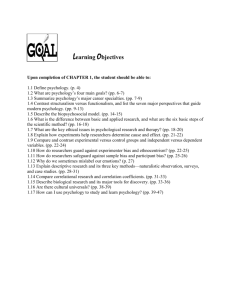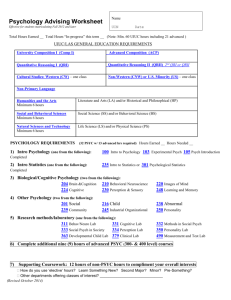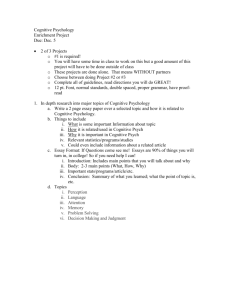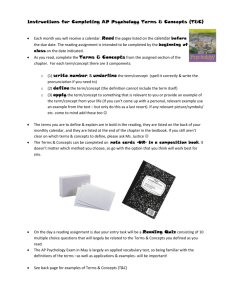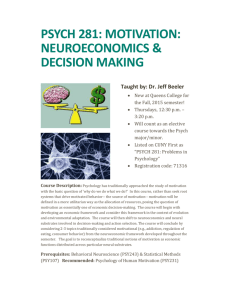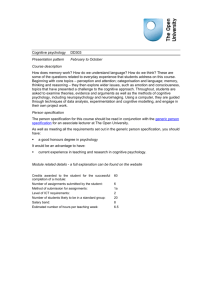1. Exam 1 - Department of Psychology
advertisement
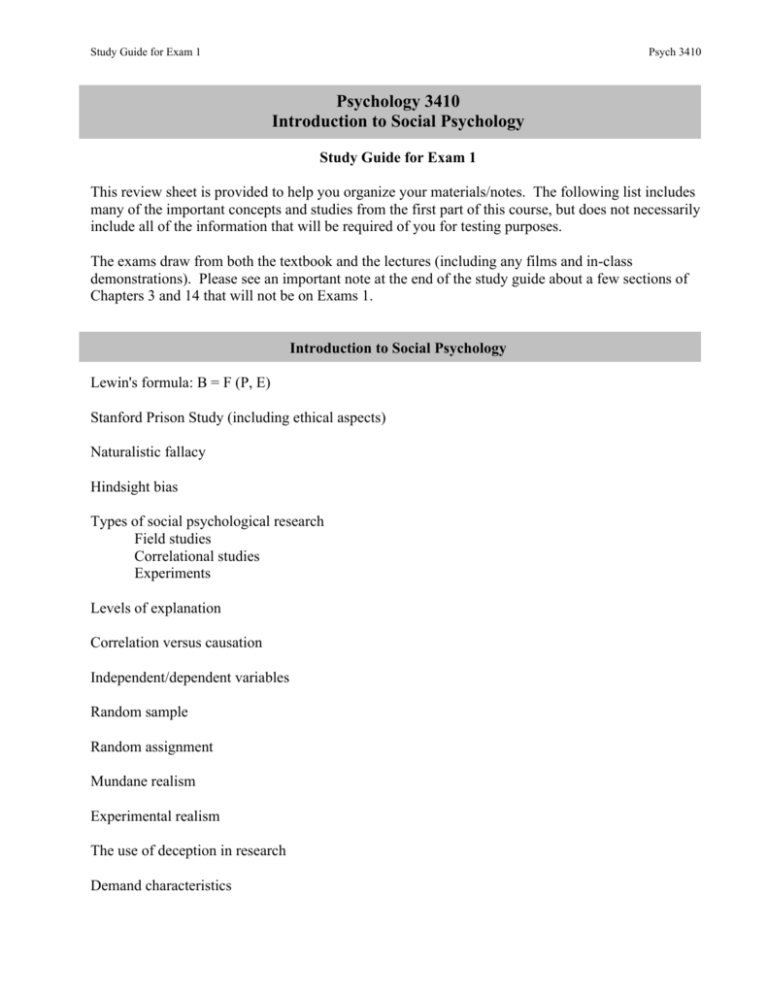
Study Guide for Exam 1 Psych 3410 Psychology 3410 Introduction to Social Psychology Study Guide for Exam 1 This review sheet is provided to help you organize your materials/notes. The following list includes many of the important concepts and studies from the first part of this course, but does not necessarily include all of the information that will be required of you for testing purposes. The exams draw from both the textbook and the lectures (including any films and in-class demonstrations). Please see an important note at the end of the study guide about a few sections of Chapters 3 and 14 that will not be on Exams 1. Introduction to Social Psychology Lewin's formula: B = F (P, E) Stanford Prison Study (including ethical aspects) Naturalistic fallacy Hindsight bias Types of social psychological research Field studies Correlational studies Experiments Levels of explanation Correlation versus causation Independent/dependent variables Random sample Random assignment Mundane realism Experimental realism The use of deception in research Demand characteristics Study guide for exam 1 Psych 3410 -2Major Topic 1: Attitudes and Behaviors 3 components of attitudes Insufficient justification Attitude-Behavior Relation influences on whether/when attitudes predict behavior LaPiere's study of restaurants Cognitive Consistency Theories: Heider's Balance Theory and the principle of least effort Cognitive Dissonance Theory Overjustification Magic Marker Study Self-perception Theory Schachter & Singer Emotion Study Sunny Day/Rainy Day Study Conditions necessary for cognitive dissonance and why The role of arousal in dissonance theory $1/$20 Dollar Study original Festinger & Carlsmith study Bem's role-playing version Understanding when cognitive dissonance theory applies versus when self-perception theory applies to a particular situation Misattribution of arousal -- the suspension bridge study Intrinsic versus extrinsic motivation Post-decisional dissonance reduction Bogus Pipeline Severity of Initiation Study Brainwashing Toaster Study Foot-in-the-door effect Grasshopper Study Self-presentation theory Robbie the Robot Study Self-affirmation theory Counterattitudinal Behavior Major Topic 2: Causal Attribution Heider's naive psychology Kelley's naive scientist model (Covariation model) Consistency information Consensus information Distinctiveness information Attributional discounting and attributional augmenting Study guide for exam 1 Psych 3410 -3- Fundamental Attribution Error (FAE) Castro speech experiment Ross et. al s quiz show study Stanford Prison Study Debate Nervous woman study Social consequences of the fundamental attribution error correspondent inference; correspondence bias Actor/Observer Bias (A/O) Taylor & Fiske Study (where are you sitting?) Who took out the garbage study Reasons for FAE and A/O bias cognitive: cognitive busyness motivational Weiner's typology of attributions for achievement or failure Attributional/explanatory style and its link to depression Locus of Control Self-serving bias Major Topic 3: Social Cognition and Social Psychology in the Clinic Social Cognition Priming Confirmation Bias Heuristics (representativeness, availability) Illusory correlation Depressive Realism Belief perseverance Attributional/explanatory style Self-fulfilling Prophecy Self-efficacy Behavioral confirmation Learned helplessness Overconfidence phenomenon Self-esteem maintenance motivation Illusion of control Reactions to threats to self-esteem; contingent self-esteem Misinformation effect Self-serving bias Study guide for exam 1 Psych 3410 -4- Unrealistic optimism Illusion of transparency Independent vs. interdependent self-concept Self-reference effect Self-presentation Social comparisons Self-handicapping Looking-Glass self Self-monitoring Individualism versus collectivism Clinical versus statistical prediction Independent versus interdependent Depressive realism Biases in predicting our own feelings and behaviors versus those of others Loneliness Biases in remembering our own feelings and behaviors False consensus effect False uniqueness effect Implicit versus explicit attitudes and implications for self reports of attitudes Self-schemas Controlled versus automatic processing Spotlight effect Information That Will Not Be on Exam 1 Mood and thinking, Myers, pages 119-120 Emotions, stress, and illness, Myers, pages 585-590 (though you should read about explanatory style and illness, pages 590-591) Social relationships and health, Myers, pages 597-602 Please note: if you are interested in any of the above topics, please ask Dr. Aspinwall. She has done research on all of them, and another social psychologist in our department, Dr. Bert Uchino, is an expert on social relationships and health. If the above topics interest you, you might also consider taking Psychology 3460 (Introduction to Health Psychology). Good luck on the exam! This document was created with Win2PDF available at http://www.daneprairie.com. The unregistered version of Win2PDF is for evaluation or non-commercial use only.

